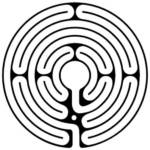Suggestions for Walking the Labyrinth
There are many ways to walk and no rules! You may be seeking relaxation, prayer, the solution to a problem, or healing. Here are some suggestions for the process that are frequently used. Use what is helpful for you. Remember, all things on your walk can instruct.
- Prepare—Focus your thoughts. Think about what you are hoping to experience during your walk—relaxation, prayer time, meditation.
- Walk in—Set your own pace. Most people find it most helpful to walk slowly. Stop whenever you wish. As you walk, let go of burdens, ideas, the need to control. Simply follow the path. Do not worry if you need to pass someone on the path or if someone needs to pass you. Remember, it is a two way path and everyone walks at their own pace.
- Center—When you reach the center, walk in and stay as long as you like. This is a place to reflect and listen to the still small voice of God.
- Walk out—When you are ready begin your journey back. Be aware of your feelings, energy, and insights.
An Ancient Prayer Form
The seven-circuit labyrinth is an ancient prayer form, rooted in the Christian tradition of pilgrimage. For medieval Christians, the labyrinth represented a path to the Holy Land. Those unable to travel far participated through visits to churches and by walking the labyrinth engraved in the floor of churches designated as pilgrimage cathedrals. By walking the labyrinth in these cathedrals, one marked the ritual ending of the journey across the countryside. In the tradition of the pilgrimage, the path of the labyrinth is called the “Road to Jerusalem.”
A Single Path
Unlike a maze, which is a puzzle of many paths from which to choose, the labyrinth is a singular road to the center and back. Following the curved path in a prayerful stance can accompany an inward journey—letting go of barriers and the busyness that stands between us and God.
The middle of the labyrinth invites us to center in God, reflecting on God’s presence, truth, and love in our lives.
As we return to the threshold of the labyrinth, we go with a greater sense of oneness with God—the Incarnation—God with us and in us. It is a time to remember and be grateful for the gifts God has given.
The labyrinth path is the same for all walkers. But each walk is a unique experience. Each walker brings a variety of cultural, religious, and spiritual traditions and understandings; their own unique hopes, dreams, history, and longings. The labyrinth is to be approached with reverence and respect for all that each journey to the center holds.
Our labyrinth is open to all and is wheelchair accessible. Please be aware that the Reformation campus is a shared and vibrant space and there may be other activities going on during your time here.

“Walking the labyrinth clears the mind and gives insight into our spiritual journey—urges action; calms us in the throes of life transitions; stirs the creative fire within; helps us see our lives within the context of a journey—a pilgrimage. They realize that they are not human beings on a spiritual path but spiritual beings on a human path. Those in deep sorrow receive solace and peace. The labyrinth is a tool for meditation, an experience of prayer, and opportunity for spiritual questioning or discernment.”
– The Rev. Dr. Lauren Artress


